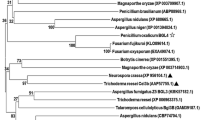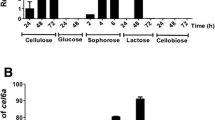Abstract
The specificity of induction of cellulose- and xylan-degrading enzymes was investigated on the yeast strain Trichosporon cutaneum CCY 30-5-4 using series of compounds structurally related to cellulose and xylan, including monosaccharides, glycosides, glucooligosaccharides and xylooligosaccharides. Determination of activities of secreted cellulase and β-xylanase, intracellular, cell wall bound and extracellular β-glucosidase and β-xylosidase revealed that: (1) The synthesis of xylan-degrading enzymes is induced in the cell only by xylosaccharides, 1,3-β-xylobiose, 1,2-β-xylobiose, 1,4-β-xylosyl-L-arabinose, 1,4-β-xylobiose and thioxylobiose being the best inducers. The xylan-degrading enzymes show different pattern of development in time and discrete cellular localization, i.e. intracellular β-xylosidase precedes extracellular β-xylanase. (2) A true cellulase is not inducible by glucosaccharides and cellulose. Negligible constitutive cellulase activity was detected which was about two orders lower than an induced cellulase in the typical cellulolytic fungus Trichoderma reesei QM 9414. (3) The best inducer of intracellular β-glucosidase splitting cellobiose was thiocellobiose in a wide range of concentration (0.1–10 mM), whereas xylosaccharides at high concentrations induced β-xylosidase of xylobiose type and a non-specific aryl β-D-glucosidase.
The results were confirmed by growing cells on cellulose and xylan. T. cutaneum was found to be a xylan-voracious yeast, unable to grow on cellulose.
Similar content being viewed by others
References
Biely P, Petráková E (1983) Specificity of induction of xylan-degrading enzyme system in Cryptococcus albidus. Abstracts to IXth International specialized symposium on yeasts, Smolenice, Czechoslovakia, p 86
Biely P, Krátký Z, Kocková-Kratochvílová A, Bauer Š (1978) Xylan-degrading activity in yeasts: growth on xylose, xylan and hemicelluloses. Folia Microbiol 23:366–371
Biely P, Vršanská M, Krátký Z (1980) Xylan-degrading enzymes of the yeast Cryptococcus albidus. Identification and cellular localization. Eur J Biochem 108:313–321
Davidson EH, Britten RJ (1979) Regulation of gene expression: possible role of repetitive sequences. Science 204:1052–1059
Dekker RFH, Richards GN (1976) Hemicellulases: Their occurrence, purification, properties, and mode of action. In: Tipson RS, Horton D (eds) Advances in carbohydrate chemistry and biochemistry, vol 32. Academic Press, New York San Francisco London, pp 278–352
Dennis C (1972) Breakdown of cellulose by yeast species. J Gen Microbiol 71:400–411
Dubois MK, Gilles A, Hamilton JK, Rebers PA, Smith F (1956) Colorimetric method for determination of sugars and related substances. Anal Chem 28:350–356
Ebringerová A, Kramár A, Rendoš F, Domanský R (1967) Die Stufenextraktion der Hemicellulosen aus dem Holz der Hagebuche (Carpinus betulus L.). Holzforschung 21:74–77
Kováč P, Petráková E (1980) Synthesis of 2-0-β-D-xylopyranosyl-D-xylose. Chem Zvesti 34:537–542
Krátký Z, Biely P, Vršanská M (1981) A method for preparing lower [U-14C)-labelled (1→4)-β-D-xylo-oligosaccharides. Carbohydr Res 93:300–303
Lowry OH, Rosebrough NJ, Farr AL, Randall RJ (1951) Protein measurement with the Folin phenol reagent. J Biol Chem 193:265–275
Mandels M, Weber J (1969) The production of cellulases. Adv Chem Ser 95:391–414
Miller GL (1959) Use of dinitrosalicylic acid reagent for determination of reducing sugars. Anal Chem 31:426–428
Montenecourt BS, Nhlapo SD, Trimiño-Vazquez H, Cuskey S, Schamhart DHJ, Eveleigh DE (1981) Regulatory controls in relation to overproduction of fungal cellulases. In: Hollaender A (ed) Trends in the biology of fermentation for fuels and chemicals, Plenum Publishing Corporation, New York, pp 33–53
Mowery DF (1963) Methyl D-mannosides. In: Whistler RL, Wolfrom ML (eds) Methods in carbohydrate chemistry, vol 2. Academic Press, New York London, pp 328–331
Paleg LG (1959) Citric acid interference in the estimation of reducing sugars with alkaline copper reagent. Anal Chem 31:1902–1904
Peciarová A, Biely P (1982) β-Xylosidases and a nonspecific wall-bound β-glucosidase of the yeast Cryptococcus albidus. Biochim Biophys Acta 716:391–399
Petráková E, Kováč P (1981) 13C-NMR spectra of isomeric D-xylobioses. Chem Zvesti 35:551–566
Reese ET (1977) Degradation of polymeric carbohydrates by microbial enzymes. In: Loewus FA, Runeckles VC (eds) Recent advances in phytochemistry, vol 11. Plenum Publishing Corporation, New York, pp 311–367
Rho D, Desrochers M, Jurasek L, Driguez H, Defaye J (1982) Induction of cellulase in Schizophyllum commune: Thiocellobiose as a new inducer. J Bact 149:47–53
Rosík J, Kubala J, Kardošová A, Kováčik V (1973) Isolation and identification of 4-0-β-D-xylopyranosyl-L-arabinopyranose from the peach gum polysaccharide. I. Chem Zvesti 27:688–691
Sadana JC, Shewale JG, Patil RV (1983) β-D-Glucosidases of Sclerotium rolfsii. Substrate specificity and mode of action. Carbohydr Res 118:205–214
Shepherd MG, Tong CC, Cole AL (1981) Substrate specificity and mode of action of the cellulases from the thermophilic fungus Thermoascus aurantiacus. Biochem J 193:67–74
Sprey B, Lambert C (1983) Titration curves of cellulases from Trichoderma reesei: demonstration of a cellulase-xylanase-β-glucosidase-containing complex. FEMS Microbiol Lett 18:217–222
Stevens BJH, Payne J (1977) Cellulase and xylanase production by yeasts of the genus Trichosporon. J Gen Microbiol 100:381–393
Stüttgen E, Sahm H (1982) Purification and properties of endo-1,4-β-xylanase from Trichosporon cutaneum. Eur J Appl Microbiol Biotechnol 15:93–99
Tansey MR (1971) Agar-diffusion assay of cellulolytic ability of thermophilic fungi. Arch Microbiol 77:1–11
Wolfrom ML, Thompson A (1963) Acetolysis. In: Whistler RL, Green JW, BeMiller JN, Wolfrom ML (eds) Methods in carbohydrate chemistry, vol 3. Academic Press, New York London, pp 143–150
Zemek J, Augustín J, Kocková-Kratochvílová A, Kuniak Ľ (1981) Production of β-glucosidase, exo-β-1,4-glucanase and endo-β-1,4-glucanase at yeast and yeast-like organisms. Biológia 36:439–444
Author information
Authors and Affiliations
Rights and permissions
About this article
Cite this article
Hrmová, M., Biely, P., Vršanská, M. et al. Induction of cellulose- and xylan-degrading enzyme complex in the yeast Trichosporon cutaneum . Arch. Microbiol. 138, 371–376 (1984). https://doi.org/10.1007/BF00410906
Received:
Accepted:
Issue Date:
DOI: https://doi.org/10.1007/BF00410906




